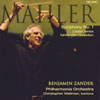Mahler Lieder eines fahrenden Gesellen; Symphony No 1
Zander talks the talk but he doesn’t walk the walk
View record and artist detailsRecord and Artist Details
Composer or Director: Gustav Mahler
Genre:
Orchestral
Label: Telarc
Magazine Review Date: 4/2006
Media Format: CD or Download
Media Runtime: 148
Mastering:
Stereo
DDD
Catalogue Number: 2CD80628

Tracks:
| Composition | Artist Credit |
|---|---|
| Lieder eines fahrenden Gesellen, 'Songs of a Wayfarer' |
Gustav Mahler, Composer
Benjamin Zander, Conductor Christopher Maltman, Baritone Gustav Mahler, Composer Philharmonia Orchestra |
| Symphony No. 1 |
Gustav Mahler, Composer
Benjamin Zander, Conductor Gustav Mahler, Composer Philharmonia Orchestra |
Author: Andrew Farach-Colton
Sad to say, but I got more from Benjamin Zander’s lecture about Mahler’s First Symphony and ‘Wayfarer’ Songs than from his performances. The symphony begins promisingly: the Philharmonia play with wonderful delicacy and, in fact, the first movement is exceptionally delicate throughout, with careful attention paid to the plethora of piano and pianissimo indications. Mahler himself noted that the one real climax came at the movement’s end. Strangely, though, this jubilant explosion is sabotaged by a change in sonic perspective; around 12 minutes in, the sound loses focus, as if the microphones had suddenly been pulled back.
The Scherzo also starts well. Zander chooses a lively tempo and the Philharmonia musicians dig in with gusto. The trio seems a bit breathless, however, and the conductor’s rubato tends to break up the phrases. There’s not enough rubato in the ‘Jewish’ music of the third movement, or something else is missing, for it sounds bizarrely ordinary in this performance. Mahler asks that the lullaby-like passage beginning at 5’45” be played ‘simply’, but surely he did not intend it to be quite so cool.
The finale should, of course, knock one sideways. Here, though, the opening barrage is foursquare, whereas the extraordinary lyrical passage at 3’55” bounces along blithely, as if it were a bit of French ballet music. Even the coda has a perfunctory air; there’s no trace of pain in those last little knife-twists at 18’32”.
The ‘Wayfarer’ Songs fare better as far as the orchestral part is concerned. The Philharmonia’s playing is finely detailed and well characterised. But Christopher Maltman seems to be looking at the songs from the outside in rather than the other way around. He sings handsomely, to be sure, but at the end my heartstrings were left untugged.
The Scherzo also starts well. Zander chooses a lively tempo and the Philharmonia musicians dig in with gusto. The trio seems a bit breathless, however, and the conductor’s rubato tends to break up the phrases. There’s not enough rubato in the ‘Jewish’ music of the third movement, or something else is missing, for it sounds bizarrely ordinary in this performance. Mahler asks that the lullaby-like passage beginning at 5’45” be played ‘simply’, but surely he did not intend it to be quite so cool.
The finale should, of course, knock one sideways. Here, though, the opening barrage is foursquare, whereas the extraordinary lyrical passage at 3’55” bounces along blithely, as if it were a bit of French ballet music. Even the coda has a perfunctory air; there’s no trace of pain in those last little knife-twists at 18’32”.
The ‘Wayfarer’ Songs fare better as far as the orchestral part is concerned. The Philharmonia’s playing is finely detailed and well characterised. But Christopher Maltman seems to be looking at the songs from the outside in rather than the other way around. He sings handsomely, to be sure, but at the end my heartstrings were left untugged.
Discover the world's largest classical music catalogue with Presto Music.

Gramophone Digital Club
- Digital Edition
- Digital Archive
- Reviews Database
- Full website access
From £8.75 / month
Subscribe
Gramophone Full Club
- Print Edition
- Digital Edition
- Digital Archive
- Reviews Database
- Full website access
From £11.00 / month
Subscribe
If you are a library, university or other organisation that would be interested in an institutional subscription to Gramophone please click here for further information.




